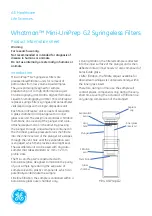
3
Q: Can the amount of total water produced be increased?
Once the system has been set for optimal operation, the overall water available for consumption
over a set period of time will be increased by increasing the storage capacity. This will increase
the time available for the unit to produce water in off-peak hours (instead of standing idle), and
more storage capacity to be available in peak hours when water usage may exceed production
capacity, for short intervals.
Q: What is the standard warranty with the Vectapure™ RSXII Lite system?
Every Vectapure™ RSXII Lite system comes with a standard one-year limited warranty on all parts
and repair labour. A detailed warranty card is included with the unit. See section 5 in this manual
for details on components with limited warranty coverage.
Q: What is the maintenance schedule for the Vectapure™ RSXII Lite system?
A good rule of thumb is to replace all pre-filters bi-monthly in commercial applications. Consider
changing them monthly when in continuous use or when used with surface water sources.
Dependent upon feed water quality, your membrane(s) should have a life expectancy of 1-5 years
.
More severe water conditions (iron, hardness) may shorten this significantly; soft water sources
may allow a membrane life of up to 8 years.
See Section 5.
Q: When should the membrane(s) be cleaned or changed?
If you notice gradually decreasing production from your system, differing taste to your drinking
water or water analyses indicate a rising TDS, it probably means that your membrane is
deteriorating and is losing its effectiveness.
Where the RO is used as a pre-treatment for a process requiring water to exact standards, you
should adopt a regular ongoing sampling and testing procedure to ensure compliance, as product
water will vary with the quality of the RO feed water.
Section 2. Designing your Installation
Your reverse osmosis system is designed to operate with feed water quality parameters that fall in
a specific range. The lifespan of the membranes and the ability of the system to produce water in
the required volume will depend largely on the feed water that is delivered to the system.
Step 1. Start with a Thorough Water Analysis
Every successful installation begins with a full analysis of the raw water source. Testing should
measure the following:
Total Hardness:
This measures the calcium and magnesium hardness in the water.
Hardness in excess of 6 grains/gallon (103 mg/l) must be pre-treated by softening.
Failure to do so will cause premature failure of the membrane through lime scaling.
Total Iron:
Iron is another common membrane foulant. Found in most water supplies,
it's particularly prevalent in supplies drawn from wells. In its ferrous state (Fe
+2
), it's
soluble. However, when it's oxidized to its ferric state (Fe
+3
), it's insoluble and forms a
precipitate. Concentrations in excess of .05 ppm must be pre-treated with an iron
remover (concentrations > 6 ppm) or combination softener
ppm); otherwise premature membrane and system equipment failure through iron
deposit fouling will result.
*
When softeners are used for iron reduction, be sure to fit your softener with a resin bed cleaner to assist in
the flushing of iron deposits from the resin bed during backwashing and regeneration.





































